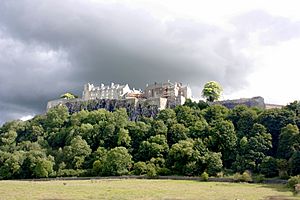Sieges of Stirling Castle facts for kids
Stirling Castle is a very old and important castle in Stirling, Scotland. It's built on a big rock and sits near the River Forth. This river crossing was a super important spot, like a main road, for getting to the north of Scotland. Because of its key location, many people wanted to control it.
Over hundreds of years, Stirling Castle was attacked and surrounded, or "besieged," at least eight times! It often changed hands between the English and Scottish armies, especially during the long wars called the Wars of Scottish Independence (1296–1357). For example, in 1299, the Scots tried to capture it from the English. Later, in 1304, Edward I of England, the King of England, attacked the Scots who were holding the castle.
The castle was also besieged three times between 1571 and 1585 by different Scottish groups during the time of King James VI. In 1651, Oliver Cromwell captured it during his invasion of Scotland. The very last time the castle was besieged was in 1746, when Charles Edward Stuart (also known as Bonnie Prince Charlie) tried to take it during the final Jacobite rising.
Contents
The Great Siege of 1304
Quick facts for kids Siege of Stirling Castle |
|||||||
|---|---|---|---|---|---|---|---|
| Part of the First War of Scottish Independence | |||||||
 Stirling Castle in 2009 |
|||||||
|
|||||||
| Belligerents | |||||||
| Kingdom of Scotland | Kingdom of England | ||||||
| Commanders and leaders | |||||||
| Sir William Oliphant | King Edward I | ||||||
| Strength | |||||||
| 30 men | 12 siege engines, including the Warwolf Unknown number of troops |
||||||
After the Scottish hero William Wallace lost the Battle of Falkirk in 1298, it took King Edward I of England six more years to fully control Scotland. The very last place that was still fighting against English rule was Stirling Castle.
Edward I's Attack
In April 1304, King Edward I brought his army to Stirling Castle. He had twelve huge machines called siege engines. These machines were like giant catapults used to throw heavy objects at castle walls. For four months, the castle was constantly hit by these machines. They threw all sorts of things, including lead balls (taken from nearby church roofs!), stone balls, and even something called Greek fire, which was a fiery weapon. Edward I even brought sulphur and saltpetre, which are ingredients for gunpowder, to the siege.
The Warwolf Trebuchet
King Edward I became impatient because the castle wasn't surrendering quickly enough. So, he ordered his best engineer, Master James of St. George, to build an even bigger and more powerful siege engine. This new machine was called the Warwolf. It was a type of trebuchet, which is a very large catapult that uses a counterweight to throw heavy projectiles a long distance.
The Castle's Defenders
Inside the castle, there were only 30 Scottish soldiers defending it. They were led by a brave knight named William Oliphant. Even though they were greatly outnumbered and constantly attacked, they held out for a very long time.
Surrender and Aftermath
Finally, on July 24, 1304, the small group of defenders was allowed to surrender. King Edward had actually refused their surrender earlier because he wanted to test out his new Warwolf machine first!
Despite his earlier threats, King Edward I decided to spare the lives of all the Scottish soldiers who had defended the castle. He only punished one Englishman who had previously given the castle to the Scots. Sir William Oliphant, the brave leader of the castle's defense, was sent to prison in the Tower of London.

